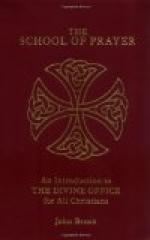“During the age of the persecutions it was scarcely possible for Christians to observe any other festival than Sunday, and so it is not surprising that the two writers who have occasion to speak of the institution of the festivals of the Church, mention only Easter and Pentecost, both of which fall on a Sunday. To these Christmas was added in the fourth century and Epiphany somewhat earlier. These chief festivals, along with others soon added to their number, formed the elements for the organisation of a festal system in the Church, as centres round which the lesser festivals grouped themselves. The last step of importance, however, in the development of the Church’s year was to connect these chief festivals with one another, so as to make them parts of a whole. The Sundays afforded a convenient means for effecting this. They were associated with the festal character of the nearest feast and were connected with it as links in a chain. The way for this development had been prepared by the season of preparation for Easter, and the Sundays in the fifty days between Easter and Pentecost— Quinquagesima—were marked with the festal character with which antiquity invested the whole period. All that was needed was, first of all, to connect Christmas, Easter and Pentecost; and, in the second place, the institution of a season of preparation before Christmas. This was accomplished between the sixth, and the eighth centuries.
“During the first six centuries the ordinary Sundays of the year had neither liturgical position or character, since they were not even enumerated. There was a sort of commune dominicarum, i.e., a number of Masses existed from which one could be chosen at will for each Sunday. To these Sundays, which were called simply dominicae quotidianae, those after Epiphany and Pentecost belonged.
“They numbered altogether twenty-nine or thirty, according as the calendar gave fifty-two or fifty-three Sundays in the year.... The smaller number of these, six at most, come between Epiphany and Septuagesima, but the larger, twenty-three to twenty-eight, between Whit Sunday and Advent. The variation depends on the date of Easter. There is no historical circumstance forthcoming to give these a specially festal character. ...” (Kellner, op. cit., pp. 176, et seq.).
Septuagesima Sunday comes nine weeks before Easter. It cannot come before the 18th January, nor after the 22nd February. It is the first day of a period of mourning and penance, preparatory to the great penitential period of Lent. On the Saturday preceding Septuagesima two alleluias are added to the Benedicamus and Deo Gratias, to intimate that the period of rejoicing in the Saviour’s birth has passed. Violet, the penitential colour, is used at Mass, and the chapters in Genesis recording the fall of Adam, warn man to think well, to humble himself and to do penance. Every part of the Office, the lessons, antiphons and hymns, bear the notes of mourning and penance.




